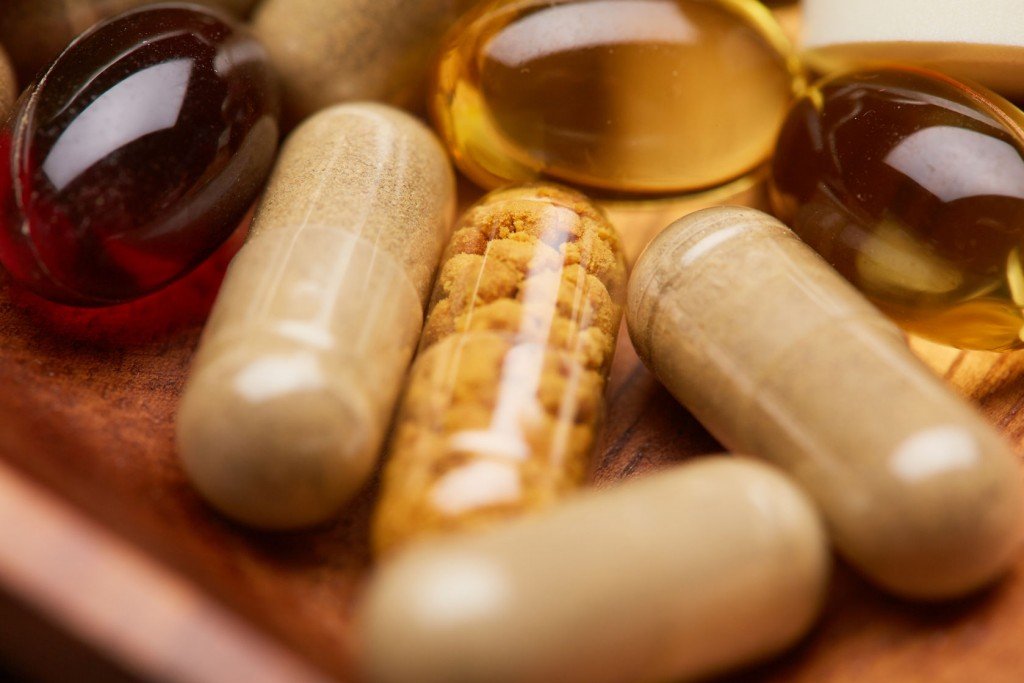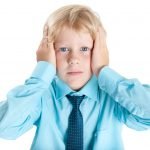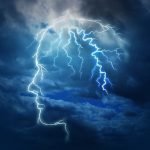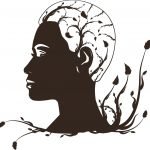Christopher Habib, BSc (Hons), ND
Chris Roberts, BSc, BEd, ND
Anxiety can take many forms. Physical symptoms of Generalized Anxiety Disorder (GAD) include fatigue, headaches, muscle tension, muscle aches, difficulty swallowing, trembling, twitching, irritability, sweating, nausea, lightheadedness, having to go to the bathroom frequently, feeling out of breath, and hot flashes.1 The conventional treatment for GAD is psychotherapy, as well as anxiolytic medications such as benzodiazepines. Unfortunately, these medications have a long list of associated adverse events which can lead to patients discontinuing treatment.2 There are many natural treatments that offer viable alternatives, including omega-3 fatty acids, inositol, L-theanine, and the herbs Piper methysticum (kava) and Withania somnifera (ashwagandha). This article will review the evidence available for these various natural therapies.
Omega-3 Fatty Acids
Omega-3 polyunsaturated fatty acids (PUFAs) are major components of brain cell membranes. Supplementation has been shown to lower anxiety and improve cognitive parameters in rodents, but very limited data is available in humans.3 An earlier human study showed that a mixture of PUFAs (including omega-3 and omega-6) was able to help students who suffered from test anxiety, compared to placebo.4 In this trial, the participants (n = 88) had improved behavioral variables associated with this type of anxiety, including appetite, mood, mental concentration, energy, academic organization, and sleep. The mixture of PUFAs also lowered cortisol levels, with a corresponding reduction in anxiety.4 A more recent randomized controlled trial examined the effect of PUFAs on anxiety symptoms and blood markers.5 The participants were 68 medical students who provided serial blood samples during low-stress periods, as well as on days before an exam. They received either 2.5 g per day of PUFAs (2085 mg of EPA and 348 mg DHA) or placebo capsules. Those students who received the PUFAs showed a 14% decrease in lipopolysaccharide-stimulated interleukin-6 (IL-6) production and a 20% reduction in anxiety symptoms. Secondary analyses showed that decreasing n-6:n-3 ratios led to lower anxiety, as well as reductions in stimulated IL-6 and tumor necrosis factor-alpha (TNFα) production. This study suggests that omega-3 fatty acids can reduce inflammation and anxiety in healthy young adults.5
Piper Methysticum (Kava)
Piper methysticum (kava) has a long tradition of use in the Southern Pacific Islands. The roots are brewed into a beverage which is consumed for its anxiolytic and hypnotic effects. There has been some concern over kava’s safety profile, which led to its withdrawal from market in Canada. The potential for hepatotoxicity, an oft-cited concern, appears to have been somewhat exaggerated.6 Kava dermopathy, a scaly rash associated with consumption of brewed kava, is seen in a fraction of chronic users and at high doses. It is reversible upon discontinuation of kava.7 In 2003, the Cochrane Collaboration published a meta-analysis of 11 studies on the treatment of anxiety with kava. They found kava superior to placebo in alleviating anxiety and concluded that it is “relatively safe” for treatment durations of 1 to 24 weeks.8
Six years later, Jerome Sarris and colleagues published KADSS, The Kava Anxiety Depression Spectrum Study.9 The authors of this randomized, placebo-controlled, crossover trial found that kava compared favorably with placebo and did so with greater magnitude than benzodiazepines. Kava was taken at a dose to provide 250 mg kavalactones in divided doses throughout the day for a period of 1 week. The side effect profile of kava was similar to that of placebo, with no clinical signs of hepatotoxicity in any participant during this trial. In comparison to standard treatment, there were fewer dropouts than in studies on benzodiazepines. Also in contrast to benzodiazepines, no adverse effects were noted on abrupt withdrawal between the kava and placebo weeks of treatment.
The lack of withdrawal side effects may lead one to consider kava as a substitute anxiolytic after treatment with benzodiazepines. Indeed, one group has studied this.10 After treatment for at least 2 weeks with a benzodiazepine, subjects were started on an initial kava dose (WS 1490 extract) of 50 mg (containing 35 mg kavalactones) or placebo. Kava dose was increased to 300 mg over 1 week, while benzodiazepine dose was tapered over 2 weeks. After 5 weeks, kava was withdrawn entirely. Based on kava’s superior performance relative to placebo in this trial, as well as the lack of adverse effects on withdrawal, the authors conclude that the herb may be useful as a substitute for benzodiazepines.
For anxiolysis, it therefore seems prudent to use an aqueous root extract dosed to contain 200-300 mg kavalactones, and given in divided doses throughout the day. Different studies have shown anxiolysis after different durations of treatment, with most trials lasting less than 4 weeks. There remains a lack of objective long-term safety data on kava.
Withania Somnifera (Ashwagandha)
Withania somnifera (ashwagandha) is an herb that has been used historically in Ayurveda for thousands of years.11 Human trials and animal research support the use of Withania for the treatment of anxiety disorders. However, there is limited research on the use of the herb as monotherapy; instead, it is often combined with other herbs or therapies. A double-blind, placebo-controlled study was conducted to evaluate the efficacy an alcohol extract of ashwagandha in patients with ICD-10 anxiety disorders.12 The study participants consisted of 20 patients who received ashwagandha and 19 who received placebo. The 2 groups were demographically and clinically similar at baseline. At 2 and 6 weeks, data from approximately 85% of patients in each group were available for analysis. The results showed statistical trends favoring ashwagandha at both time points. At the 6-week follow-up, significantly more patients met a priori response criteria in the ashwagandha group (88.2%), as compared with the placebo group (50%). Ashwagandha was well-tolerated and did not cause any significant adverse events. The authors conclude that the alcohol extract of Withania has useful anxiolytic properties.12
An open-label, longitudinal human trial demonstrated the anxiolytic potential of a compounded natural health product which had Withania as the main herb.13 The compound consisted of a mixture of 8 herbs in total. Eighteen participants were followed over a period of 3 months, and 17 patients completed the study. Primary endpoints included scores from 4 validated questionnaires (SF36 Health Survey, Perceived Stress Scale, State-Trait Anxiety Inventory, and Beck Depression Inventory); serum DHEA, ALT, AST, and creatinine all measured at 12 weeks. Except for the physical summary score of the SF36 questionnaire, all the subjective scores indicated a highly significant (p < 0.0001) improvement in the participants’ ability to cope with stress (including a 46% improvement in self-perceived stress, a 67% improvement in the Beck Depression Index, and a 72% improvement in the mental summary score of the SF-36). No adverse effects were reported and there was no evidence of damage to the liver or kidney based on serum markers.13
A more recent human trial examined the use of ashwagandha as part of naturopathic care for anxiety.14 Employees from the Canada Post Corporation with moderate-to-severe anxiety were randomized to receive standard psychotherapy or naturopathic care for a period of 12 weeks. Naturopathic care consisted of standard psychotherapy, dietary counseling, deep breathing relaxation techniques, a standard multivitamin, and ashwagandha at the dose of 300 mg BID, standardized to 1.5% withanolides prepared from the root. The results showed that final Beck Anxiety Inventory scores decreased significantly by 56.5% in the naturopathic care group, compared to 30.5% in the psychotherapy group. Significant differences between groups were also observed in mental health, concentration, fatigue, social functioning, vitality, and overall quality of life, with the naturopathic care group exhibiting greater clinical benefit. No serious adverse reactions were observed.14
Inositol
Inositol has been investigated for treatment of anxiety and, in particular, panic disorder. One double-blind, controlled, crossover trial compared inositol to fluvoxamine for this condition.15 Twenty subjects of both sexes, aged 18-65 years, were treated with 18 g of inositol daily for 1 month (for the first week, a dose of 12 g was used). Results for inositol compared favorably to fluvoxamine in terms of panic attacks (reduction in number of panic attacks per week by 4 for inositol, 2.4 for fluvoxamine); for general anxiety symptoms, the 2 treatments were comparable in potency (as assessed by Clinical Global Impressions Scale score).15 A previous study with 25 subjects, mean age 35.8 years, had found inositol at 12 g daily for 4 weeks to be superior to placebo for reducing frequency of panic attacks (from an average of 10 per week, to 3.5 for inositol and 6 for placebo).16
A smaller study (n=13) investigated inositol for the treatment of obsessive-compulsive disorder.17 A dose of 18 g inositol daily for 6 weeks, administered to subjects of both sexes, aged 23-56, reduced symptoms of this disorder (as assessed by the Yale-Brown Obsessive Compulsive Scale) at a magnitude superior to placebo. When evaluated for the treatment of bulimia and binge eating in another smaller study (n=12), inositol was also found to have positive effects.18 Eighteen grams of inositol was used for 6 weeks in patients aged 20-39 (dose was lowered to 12 g per day for patients who experienced gastrointestinal side effects; this dose change eliminated the side effects). There was only 1 male patient included in this study, and he did not respond to treatment. As has been outlined above, the typical dose for anxiolysis is 12-18 g, which is relatively high in comparison to the doses used for other conditions. Side effects at this higher dose have been known to include mild gastrointestinal distress. It is also noteworthy that recent research has found that a myo-inositol dose can likely be reduced by 70% to a more manageable 3.6-5.4 g if taken in a soft gel-capsule formulation.19
L-theanine
L-theanine, an amino acid contained in green tea leaves, has been considered to have anti-stress effects by inhibiting cortical neuron excitation, thus could be utilized as an anxiolytic. In one study, 200 mg of L-theanine or caffeine plus placebo were administered to 14 participants.20 The subjects then performed mental and physiological tasks under conditions of physical or psychological stress, and completed a Profile of Mood States questionnaire. The results showed that L-theanine reduced the Tension-Anxiety score (on a scale of 1 to 10) to 1 point, as compared with placebo, which reduced the score to approximately 6 points.
In another study, L-theanine was compared with a standard benzodiazepine (alprazolam) and placebo on behavioral measures of anxiety in healthy human subjects using the model of anticipatory anxiety.21 Sixteen healthy volunteers received 1 mg of alprazolam, 200 mg of L-theanine, or placebo in a double-blind, placebo-controlled, repeated-measures design. The acute effects of alprazolam and L-theanine were assessed under a relaxed and experimentally-induced anxiety condition. Subjective reports of anxiety were completed, including the Beck Anxiety Inventory, the Visual Analog Mood Scale, and the State-Trait Anxiety Inventory. These were completed before, during, and after task administration. The results showed that L-theanine caused relaxing effects during baseline on the tranquil-troubled subscale of the Visual Analog Mood Scale. Neither L-theanine nor alprazolam had any significant anxiolytic effects during the experimentally-induced anxiety state. The authors conclude that L-theanine may have some relaxing effects under resting conditions, but that neither L-theanine nor alprazolam demonstrate any acute anxiolytic effects under conditions of increased anxiety in the anticipatory anxiety model.21
Conclusion
This article has reviewed the evidence relating to several natural treatments of anxiety. Promisingly, these interventions have, in some studies, shown comparable efficacy to pharmaceutical therapies, while their side-effect profile, according to the evidence so far gathered, often appears less severe. While this article has focused on botanical and nutritional supplements, it is important to note that lifestyle factors, including sufficient sleep, regular exercise, a healthy diet, and social support should be addressed as critical components of care. In this way, anxiety in its many forms may be addressed in a holistic, evidence-based manner.
 Christopher Habib, BSc (Hons), ND is the clinic director of the multi-disciplinary clinic, Mahaya Forest Hill Integrative Health, in Toronto, Canada. He also holds a position at the Canadian College of Naturopathic Medicine, where he is a clinic supervisor and teaches. Chris has completed an accredited 2-year research residency at the college, making him the first person in Canada to complete this residency. Chris also holds an Honours Bachelor of Science from the University of Toronto.
Christopher Habib, BSc (Hons), ND is the clinic director of the multi-disciplinary clinic, Mahaya Forest Hill Integrative Health, in Toronto, Canada. He also holds a position at the Canadian College of Naturopathic Medicine, where he is a clinic supervisor and teaches. Chris has completed an accredited 2-year research residency at the college, making him the first person in Canada to complete this residency. Chris also holds an Honours Bachelor of Science from the University of Toronto.
 Chris Roberts, BSc, BEd, ND has an anxiety-centered practice at Mahaya Forest Hill Integrative Health in Toronto, Canada. His focus on anxiety arose during a 2-year clinical residency, which he completed after graduating from the Canadian College of Naturopathic Medicine. In addition to private practice, Chris coordinates and lectures in the Clinical Medicine course at the Canadian College of Naturopathic Medicine. He holds a Bachelor of Science from the University of Toronto where his studies focused on human biology and anthropology. He also holds a Bachelor of Education from the Ontario Institute for Studies in Education.
Chris Roberts, BSc, BEd, ND has an anxiety-centered practice at Mahaya Forest Hill Integrative Health in Toronto, Canada. His focus on anxiety arose during a 2-year clinical residency, which he completed after graduating from the Canadian College of Naturopathic Medicine. In addition to private practice, Chris coordinates and lectures in the Clinical Medicine course at the Canadian College of Naturopathic Medicine. He holds a Bachelor of Science from the University of Toronto where his studies focused on human biology and anthropology. He also holds a Bachelor of Education from the Ontario Institute for Studies in Education.
References
Spitzer RL, Kroenke K, Williams JB, Lowe B. A brief measure for assessing generalized anxiety disorder: the GAD-7. Arch Intern Med. 2006;166(10):1092-1097.
Martin JL, Sainz-Pardo M, Furukawa TW, et al. Benzodiazepines in generalized anxiety disorder: heterogeneity of outcomes based on a systematic review and meta-analysis of clinical trials. J Psychopharmacol. 2007;21(7):774-782.
Takeuchi T, Iwanaga M, Harada E. Possible regulatory mechanism of DHA-induced anti-stress reaction in rats. Brain Res. 2003;964(1):136-143.
Yehuda S, Rabinovitz S, Mostofsky DI. Mixture of essential fatty acids lowers test anxiety. Nutr Neurosci. 2005;8(4):265-267.
Kiecolt-Glaser JK, Belury MA, Andridge R, et al. Omega-3 supplementation lowers inflammation and anxiety in medical students: a randomized controlled trial. Brain Behav Immun. 2011;25(8):1725-1734.
Ulbricht C, Basch E, Boon H, et al. Safety review of kava (Piper methysticum) by the Natural Standard Research Collaboration. Expert Opin Drug Saf. 2005;4(4):779-794.
Norton SA, Ruze P. Kava dermopathy. J Am Acad Dermatol. 1994;31(1):89-97.
Pittler MH, Ernst E. Kava extract for treating anxiety. Cochrane Database Syst Rev. 2003;(1):CD003383.
Sarris J, Kavanagh DJ, Byrne G, et al. The Kava Anxiety Depression Spectrum Study (KADSS): a randomized, placebo-controlled crossover trial using an aqueous extract of Piper methysticum. Psychopharmacology (Berl). 2009;205(3):399-407.
Malsh U, Kieser M. Efficacy of kava-kava in the treatment of non-psychotic anxiety, following pretreatment with benzodiazepines. Psychopharmacology (Berl). 2001;157(3):277-283.
Ven Murthy MR, Ranjekar PK, Ramassamy C, Deshpande M. Scientific basis for the use of Indian ayurvedic medicinal plants in the treatment of neurodegenerative disorders: ashwagandha. Cent Nerv Syst Agents Med Chem. 2010;10(3):238-246.
Andrade C, Aswath A, Chaturvedi SK, et al. A double-blind, placebo-controlled evaluation of the anxiolytic efficacy of an ethanolic extract of withania somnifera. Indian J Psychiatry. 2000;42(3):295-301.
Seely D, Singh R. Adaptogenic potential of a polyherbal natural health product: report on a longitudinal clinical trial. Evid Based Complement Alternat Med. 2007;4(3):375-380.
Cooley K, Szczurko O, Perri D, et al. Naturopathic care for anxiety: a randomized controlled trial ISRCTN78958974. PLoS One. 2009;4(8):e6628.
Palatnik A, Frolov K, Fux M, Benjamin J. Double-blind, controlled, crossover trial of inositol versus fluvoxamine for the treatment of panic disorder. J Clin Psychopharmacol. 2001;21(3):335-339.
Benjamin J, Levine J, Fux M, et al. Double-blind, placebo-controlled, crossover trial of inositol treatment for panic disorder. Am J Psychiatry. 1995;152(7):1084-1086.
Fux M, Levine J, Aviv A, Belmaker RH. Inositol treatment of obsessive-compulsive disorder. Am J Psychiatry. 1996;153(9):1219-1221.
Gelber D, Levine J, Belmaker RH. Effect of inositol on bulimia nervosa and binge eating. Int J Eat Disord. 2001;29(3):345-348.
Carlomagno G, De Grazia S, Unfer V, Manna F. Myo-inositol in a new pharmaceutical form: a step forward to a broader clinical use. Expert Opin Drug Deliv. 2012;9(3):267-271.
Yoto A, Motoki M, Murao S, Yokogoshi H. Effects of L-theanine or caffeine intake on changes in blood pressure under physical and psychological stresses. J Physiol Anthropol. 2012;31:28.
Lu K, Gray MA, Oliver C, et al. The acute effects of L-theanine in comparison with alprazolam on anticipatory anxiety in humans. Hum Psychopharmacol. 2004;19(7):457-465.





